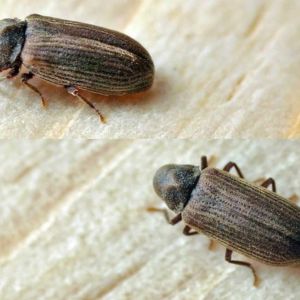How to manage Woodworm
Learn methods for identifying and managing woodworms to safeguard your home and business.

What actually are woodworms ?
Woodworm, scientifically known as Anobium punctatum, belongs to the class Insecta and order Coleoptera. These small, brown beetles lay their eggs in wood crevices. Larvae, commonly referred to as woodworms, hatch and tunnel through the wood, consuming cellulose. Their behavior poses a threat to wooden structures, furniture, and objects.
Woodworms prefer damp and humid environments, often inhabiting old buildings, furniture, and even trees. They thrive in moist conditions, making wooden items in such surroundings susceptible to infestations. If left unchecked, woodworms can weaken structures, causing structural damage over time. While woodworms primarily target wood, they generally do not pose a direct threat to human life. However, their activity can lead to the deterioration of wooden structures, impacting property value and safety.
Regular inspections, maintenance, and controlled moisture levels can help prevent woodworm infestations and safeguard wooden items.

Life Cycle of Woodworm
The woodworm’s lifecycle progresses through various stages, beginning with eggs, then advancing to larvae, pupae, and ultimately reaching the adult stage. This sequence illustrates the complete development process of the woodworm.
Once hatched, the eggs transition into the larval stage. Larval woodworms sustain themselves by consuming wood, causing damage as they tunnel through it. The duration of this stage varies from weeks to months based on environmental factors.
During the pupal stage, woodworms undergo a transformation within the protective cocoons they create.
After undergoing multiple changes within the cocoon, woodworms emerge as adult beetles. In this stage, they are prepared for reproduction. The size of adult woodworms varies according to the species.
Types of Woodworm

Common Furniture Beetle
This species is relatively small, measuring around 2.7 to 4.5 mm in length and being dark brown in color. These beetles have a flattened body shape and can destroy various types of wood. They are typically found in humid environments.

Deathwatch Beetle
Larger than the common furniture beetle, measuring about 5 to 7 mm, they come in both brown and gray colors. They tend to inhabit hardwood that has undergone fungal decay and are often responsible for infestations in roof timbers and wooden support structures.

Powderpost Beetle
Known for their ability to transform wood into fine powder, these beetles are aptly named powder post beetles. They excel at creating narrow tunnels within wood. They are commonly sized between one and seven mm and can appear in different colors, ranging from reddish-brown to black.

House Longhorn Beetle
With a larger size of around 10 to 25 mm and an elongated body, these beetles exhibit gray to brown coloring with white dots.
They infest softwoods and have a preference for wood with a high moisture content.
Overcoming woodworm infestation
Woodworm infestations can pose a significant threat to wooden structures and properties. These tiny creatures, the larvae of wood-boring beetles, have the potential to cause severe damage to wood over time. To safeguard your wooden belongings and properties from the destructive impact of woodworms, it’s essential to take proactive measures.
One such effective solution in Dubai is Al Rasa pest control services. They specialize in tackling woodworm infestations and offer comprehensive solutions to protect your wooden assets. With their expertise and experience, they can assess the extent of the infestation, determine the appropriate treatment method, and apply it to eliminate the wood-boring pests.
Frequently Asked Questions
The signs of a woodworm infestation include small,round holes on wooden surfaces and powdery frass near these holes. Additionally, weakened wood that crumbles easily when touched can be an indicator
Various types of wood-boring insects fall under the category of woodworms, with different characteristics and behaviors depending on the species.
Woodworms do not pose health risks to humans, but they can damage wooden structures and furniture.
While DIY treatments can help manage woodworm infestations, they may not provide a permanent solution. For a lasting fix, it’s recommended to involve a professional pest control service.
In cases where the treatment isn’t effective, there’s a risk of reinfestation. To achieve a more reliable solution, it’s advisable to consult a professional pest control expert.
Some facts and information about Woodworm
- Woodworms are not actual worms; the term refers to wood-boring beetles.
- Woodworm infestations are common in humid, moist environments.
- Woodworms thrive in historical wooden structures and antique furniture due to the higher moisture content.
- Different wood-boring beetle species create distinct holes, aiding in identifying the type of infestation.

The journey begins with the egg Woodworm life begins with the laying of tiny eggs on wood surfaces, often within cracks or crevices. Detecting these minuscule eggs can be challenging due to their size.